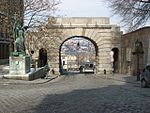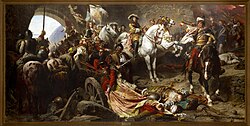Lutheran Church of Budavár
19th-century churches in HungaryBuda CastleChurches completed in 1895Churches in BudapestEclectic architecture

Lutheran Church of Budavár is the oldest Lutheran church of Buda. It was built in 1895 at Vienna Gate Square in the 1st District of Budapest. The first church for the Lutherans of Buda was built by Maria Dorothea, third wife of Palatine Joseph, in 1846, at hu:Dísz tér. The site was taken over by the Ministry of Defence, so a new church was built near Vienna Gate.
Excerpt from the Wikipedia article Lutheran Church of Budavár (License: CC BY-SA 3.0, Authors, Images).Lutheran Church of Budavár
Táncsics Mihály utca, Budapest Castle District
Geographical coordinates (GPS) Address Phone number Website External links Nearby Places Show on map
Geographical coordinates (GPS)
| Latitude | Longitude |
|---|---|
| N 47.504722222222 ° | E 19.030833333333 ° |
Address
Budavári evangélikus templom
Táncsics Mihály utca 28
1014 Budapest, Castle District
Hungary
Open on Google Maps











